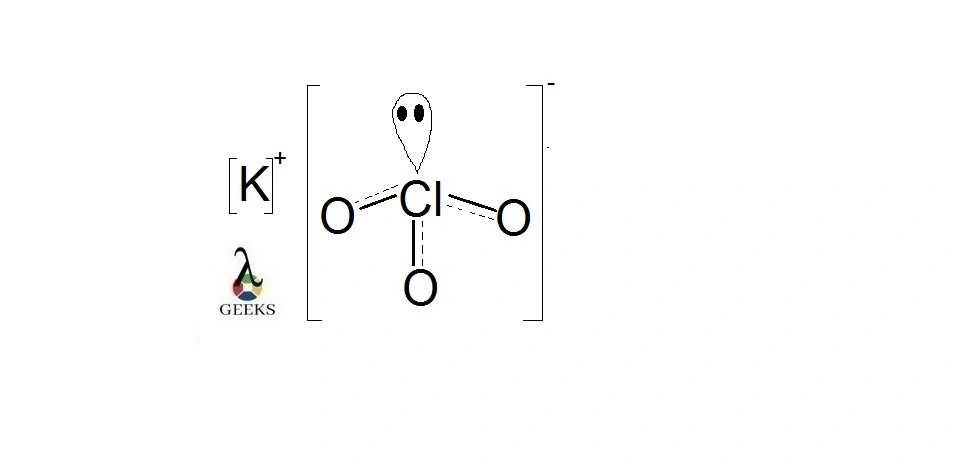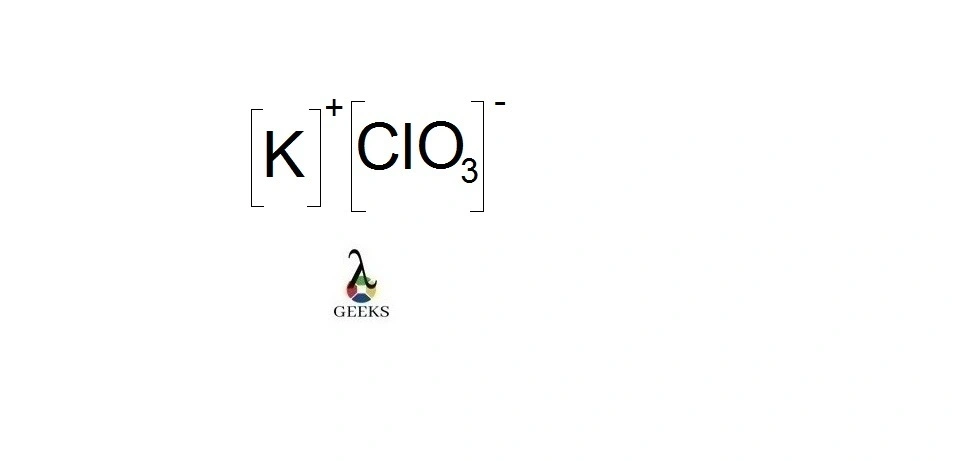Potassium chlorate or KClO3 is a white crystalline substance in its pure form. Let us talk about important characteristics of KClO3 in details below.
KClO3 is one of the most commonly used chlorate compound. It has saline taste as an inorganic salt. It is used in fireworks, in agriculture as components of pesticides.
KClO3 is a chemical oxygen generator.Let us discus how to draw KClO3 lewis structure along with some properties like solubility, electrolytic nature and other facts of KClO3 lewis structure below.
How to draw KClO3 lewis structure?
Oxidizing agent KClO3 lewis structure can be drawn by following steps below.
Step 1: counting participating electrons of atoms
Total 26 valence electrons participated in KClO3 lewis structure bond formation. These electrons can be counted from the positions of the atoms in the molecule as potassium is a group 1 element; oxygen is from group 16 and chlorine is from group 17.
Step 2: electron transferring and ion formation
Potassium has one excess electron which prohibits it from getting stable configuration like nearest noble gas argon. Hence this electron is fully transferred to form chlorate ion.
Step 3: charge neutralization
Ions are drawn inside third bracket while the charges over the ions are shown outside the bracket. In KClO3 lewis structure both ions have single charge over them which are shown with the type of charges.
KClO3 lewis structure shape
Lewis structure shape can be stated from hybridization of covalent molecule which creates a particular geometry. Let us discuss if we can identify shape of KClO3.
KClO3 lewis structure has no particular shape as it is not formed by hybridization of orbitals. Oppositely charged ions arranged compactly by strong force to form monoclinic lattice structure.

KClO3 lewis structure formal charge
Formal charge is a concept of covalent compound to select most stable canonical form with minimum charge for each atom. Let us figure out the formal charge for KClO3.
Formal charge for KClO3 structure can not be calculated as it is ionic compound and electron cloud is not shared in it. One KClO3 molecule contains positively charged potassium ion (K+) and negatively charged chlorate ion (ClO3-). These opposite charges can cancel each other to become neutral.
KClO3lewis structure angle
Lewis structure angle is measured for covalent compound between the overlapping hybrid orbitals which form bond. Let us find if we can measure this for KClO3.
KClO3 lewis structure angle can not be determined like covalent molecules with help of VSEPR theory. Here oppositely charged ions arranged themselves in certain manners to form lattice. Covalent bond angle is only measured through hybrid orbital formation which is not possible for KClO3.
KClO3 lewis structure octet rule
Electrons have to arrange in such a manner that there would be less repulsion and it is possible if last orbit is octet filled. Let us explore further this for KClO3.
All the atoms in KClO3 do not follow the octet rule because chlorine has exception. In the molecule chlorine of chlorate has more electrons in valence shell than eight. This is because it has ‘d’ sub-shell to accept electron in the 3rd orbit, can increase its oxidation state.
KClO3 lewis structure lone pairs
Lone pairs are the concentrated electron cloud which do not involve in bonding and remain to parent atom. Let us find if KClO3 has such nonbonding electron.
KClO3 has no lone pair electrons as it is an ionic compound, electrons fully transferred from acceptor to donor. Although chlorate ion contains nonbonding electron pair which concentrate over chlorine atom.
Lone pairs of oxygen atoms of chlorate are not counted as they participated in canonical structure formation.
KClO3 valence electrons
Valence electrons are those which can go to higher excited state to form chemical bond of molecule. Let us know about these loosely bounded electrons of KClO3.
Total 26 valance electrons are participated in the chemical bonding of one KClO3 molecule. There are 26 outer orbit electrons in chlorate ion among which one electron is transferred to positively charged (K+) ion to form ionic bond.
KClO3 hybridization
Hybridization is intermixing of last shell orbitals where new hybrid orbital contains some of percentage of parent orbitals. Let us explore if we can see this in KClO3.
Hybridization can not be seen in KClO3 molecule. This is because being an ionic compound it does not need hybrid orbital for better overlapping in chemical bond. Electron cloud is directly shifted from chlorate ion and ionic bond forms by strong attracting force.
KClO3 solubility
Solubility of a compound in any solvent is measured by the amount which solvated to form saturated solution. Let us talk about solubility of KClO3 in different solvents.
| Solvent | magnitude |
| Water at 0 degree Celsius | 3.13 g/ 100 ml |
| Water at 25 degree Celsius | 8.15 g/ 100 ml |
| Water at 100 degree Celsius | 53.51 g/ 100 ml |
| Glycerol at 20 degree Celsius | 1 g/ 100 g |
| acetone | negligible |
KClO3 is soluble in water and forms colorless solution. Solubility increases with temperature because with increasing temperature kinetic energy increases in solute (KClO3), helps to dissociate more.
Is KClO3 solid or liquid?
Solid and liquid are state of matter which can be differentiate by the force between the atoms either electrostatic or vander waals force. Let us explore this for KClO3.
KClO3 is crystalline solid matter. This is because ions bounded by strong electrostatic force arranged compactly to develop monoclinic crystals. This solid state of compound can be justified by its high melting point that is 356 degree Celsius as it needs much energy to break the lattice energy.
Is KClO3 polar or nonpolar?
Polarity is that physical property which can be measured for covalent compound having dipole in bonds. Let us explain why we can not measure the polarity of KClO3.
KClO3 is a nonpolar compound because it has ionic bond between two oppositely charged ions. This chemical bond is formed by completely electron transferring to complete the octet. Hence there is no partial charge and dipole formation, polarity can not be measured.
Is KClO3 acidic or basic?
Acid are the compounds which forms conjugate base and base can forms conjugate acid in reaction. Let us see if we can call KClO3 acid or base.
KClO3 is an inorganic neutral salt compound. This is because it is resulted in the reaction of chloric acid (HClO3)and base KOH. In this neutralization reaction water (H2O) molecule is formed along with salt KClO3. The pH of the reaction medium becomes neutral around 7.
Is KClO3 electrolyte?
Electrolytes are the substances which can carry electricity through loosely bounded electrons in valence bond. Let us understand if KClO3 has this capacity.
KClO3 is weak electrolyte in solid state but is a strong electrolyte in liquid state. In solid state the ions are tightly bounded by strong intramolecular force and can not separate to carry charge. In liquid state the ions are in mobile state which can easily carry current.

Is KClO3 ionic or covalent?
Ionic or covalent compound can be distinguished by the electron transferring method when chemical bond is formed. Let us talk about the bonding nature of KClO3.
KClO3 is an ionic compound though it has covalent bonds in the chlorate ion. Positively charged potassium ion and negatively charged chlorate ion formulate the compound by fully electron transferring.
Conclusion:
KClO3 is an ionic molecule and strong oxidizing agent which can oxidize other molecules and reduce itself. It can be generated in as salt in neutralization reaction which affects its properties.
Also Read:
- Sco lewis structure
- Caf2 lewis structure
- Pf3 lewis structure
- Xe lewis structure
- Clo4 lewis structure
- Clcn lewis structure
- Cl2o lewis structure
- Br3 lewis structure
- Cos lewis structure
- Asf3 lewis structure

Hi…I am Triyasha Mondal, pursuing M.Sc in Chemistry. I am an enthusiastic learner. My specialization is in physical chemistry.
Let’s connect through LinkedIn: